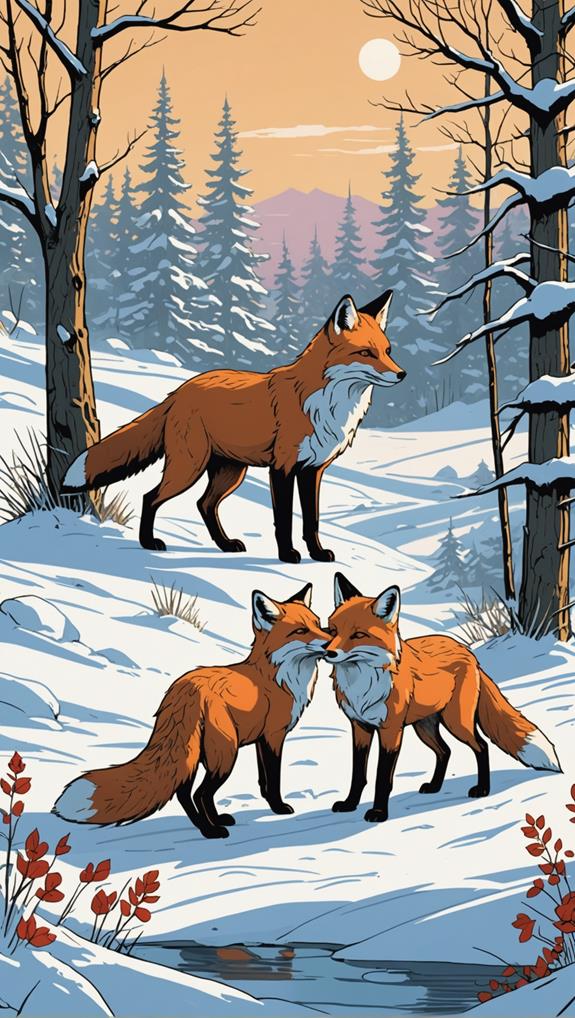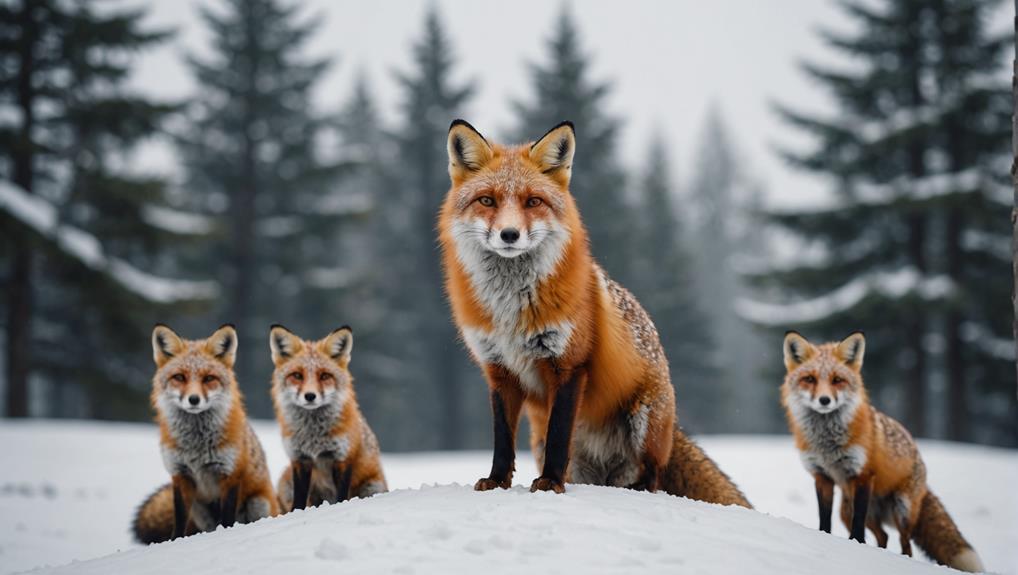You might think that red foxes are solitary creatures, only coming together for mating or to fight over resources. But, in reality, they live in complex social groups with a fluid hierarchy that's constantly shifting. As you explore the intricacies of their social dynamics, you'll discover that dominance is visually displayed through body language, and territoriality plays a crucial role in their daily lives. But what's truly fascinating is how they balance competition for resources with cooperative behaviors like grooming and vocalizations that strengthen their social bonds – and that's just the beginning of the story.
Contents
Fox Social Hierarchy Dynamics
How do red foxes establish their social hierarchy, and what factors influence their dominance dynamics? You might be surprised to learn that their social hierarchy is quite flexible and influenced by various factors such as size, strength, and individual interactions.
Dominant individuals typically control territory and breeding opportunities, which is crucial for their reproductive success. In fact, a red fox's average home range of approximately 730 acres plays a significant role in their territorial behaviors and social dynamics. Additionally, their adaptability to both wild and urban areas affects their social structure, as urban foxes often have smaller home ranges and different diets.
As you observe their social behavior, you'll notice that dominant foxes display erect tails and upright ears, while submissive individuals lower their heads and flatten their ears. Aggression is prevalent among cubs as they establish their hierarchy, with fights occurring as early as three weeks old. This competitive behavior leads to a mortality rate of around 20% for cubs.
Interestingly, dominance hierarchies can shift rapidly in response to changes in group composition, such as the introduction or removal of individuals, emphasizing the fluidity of social status in fox communities. Seasonal dynamics also play a significant role, with dominant vixens primarily breeding and hierarchical reshuffles occurring in anticipation of mating seasons, impacting lower-ranking individuals.
Aggression and Competition Patterns
In a typical litter of red fox cubs, around 20% won't survive their early competitive struggles, as aggression begins as early as three weeks old.
You might be surprised to learn that size and strength play a significant role in determining their hierarchy, with the strongest cubs getting priority access to food.
Interestingly, their adaptability to various environments, such as urban settings with parks and gardens, also influences their social dynamics.
As they grow, adult males take aggression to the next level during mating seasons, engaging in physical confrontations that can lead to facial and neck injuries.
But it's not all about fighting – social interactions among red foxes are governed by a fluid hierarchical system, where dominant individuals manage territory and breeding opportunities.
Subordinate foxes often mimic submissive behaviors to reduce conflict, like displaying lowered heads and flat ears to signal their social standing.
When competition over resources, particularly food, gets intense, territorial disputes arise, and foxes resolve conflicts through displays rather than physical fights, highlighting the complexity of their social interactions.
Communication and Social Behavior

Frequently, social interactions among red foxes are characterized by a rich tapestry of communication and behavior, which plays a vital role in maintaining group cohesion and stability.
You'll notice that grooming behaviors are essential for building strong social bonds and preventing social isolation, which can have significant implications for group cohesion.
In urban environments, foxes have developed boldness with humans Behavioral Flexibility to adapt to human-dominated landscapes, showcasing their remarkable ability to thrive in diverse settings.
Body language also plays a critical role in communication, where dominant individuals exhibit upright postures and submissive foxes show lowered heads and flat ears.
Vocalizations, like "gekking," serve as indicators of heightened aggression during conflicts, highlighting the emotional complexity of social interactions among foxes.
Play fighting among cubs is vital for establishing hierarchy and developing essential social skills, while foxtrot behavior allows for non-contact displays to reinforce social order.
Without grooming and social interaction, foxes may disperse, demonstrating the importance of social engagement for group stability.
Territoriality and Resource Management
As you delve into the world of red foxes, you'll find that territoriality and resource management are crucial aspects of their social dynamics. Dominant red fox pairs primarily manage territories, often engaging in intrasexual aggression to defend their resources against rivals.
Food plays a significant role in shaping their social interactions, with competition starting early in cubs and territorial disputes becoming more pronounced during periods of food scarcity.
Interestingly, aggressive encounters between foxes can be mitigated by employing body language and vocalizations, with many conflicts resolved without physical fighting.
Territory size and the number of residents can fluctuate seasonally, with higher interaction rates observed among overlapping territories, particularly during the winter months.
Within fox groups, a controlled hierarchy exists, where dominant individuals gain preferential access to resources, establishing social stability vital for successful reproduction and cub rearing.
Breeding Dynamics and Seasonal Shifts

Two months of the year, January and February, are crucial for red foxes as they mark the peak breeding season. During this time, receptive vixens are in heat for about 20 days, and males go into high gear, roaming around to find mating opportunities.
You might think it's a free-for-all, but dominant pairs within a social group typically ensure they're the only ones breeding. In some cases, up to three vixens may reproduce concurrently, but that's not the norm. The average litter size for red foxes ranges from 4 to 5 cubs, with peak birth rates noted in mid-March when environmental conditions are favorable for raising young.
As the seasons shift, particularly in autumn, social dynamics change. Male cubs reach sexual maturity, and tensions rise within family groups, leading to potential dispersal and changes in social structure.
The social hierarchy plays a significant role in reproductive success, as dominant individuals often disrupt breeding opportunities for lower-ranking members during pre-breeding confrontations. It's a delicate balance, but understanding these breeding dynamics and seasonal shifts can help you appreciate the complex social lives of red foxes.
Frequently Asked Questions
What Is the Social Behavior of the Red Fox?
You'll notice that red foxes exhibit complex social behavior, involving mating rituals, vocal communication, and territory marking, while they also engage in play behavior, develop hunting techniques, and maintain grooming habits, all influenced by their dominance hierarchy and juvenile development.
What Is the Social Structure of a Fox?
You'll find that a fox's social structure revolves around a nuclear family, where you'll see them using various communication methods like vocalizations and scent marking to maintain their red fox territory, while also engaging in grooming behavior, mating rituals, and playful hunting collaborations.
Do Foxes Form Social Groups?
You'll find that foxes do form social groups, which are crucial for their complex behaviors like fox communication, territorial disputes, and mating rituals, all of which shape their social hierarchy and play a role in their play behavior and scent marking.
What Is the Family Structure of a Red Fox?
You're about to unravel the intricate web of a red fox family, where a breeding pair weaves a tapestry of territory setup, pup rearing, and scent marking, with parental roles, feeding hierarchy, and vocal communication harmoniously intertwined.
Final Thoughts
As you've learned, red foxes' social dynamics are a fascinating mix of hierarchy, competition, and cooperation. One surprising fact: did you know that in some populations, up to 40% of red fox kits are raised by adoptive parents, highlighting their remarkable flexibility in family structures? This adaptability, combined with their complex communication and social bonds, makes their societies truly unique in the animal kingdom.














